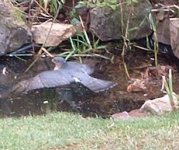Gerry Hooper
Certified User
I got a shock this morning when I walked out the back door to see a Sparrowhawk floating in the pond.See Attached pic.
It was struggling with something in his talons, the struggling stopped and it emerged from the pond carrying a large rat.
It was too heavy for it to lift over the hedge so it spent 20 mins. devouring it on the lawn.
Is it unusual for Sparrowhawks to take anything other than birds, there's no mention of it in any books I've got.
The rats do sit on the bird table and even climb the tree to get to the feeders,maybe the Sparrowhawk made a mistake.
Also, would it of intentionally taken the rat to the pond to drown it or was that just a happy accident?
It was struggling with something in his talons, the struggling stopped and it emerged from the pond carrying a large rat.
It was too heavy for it to lift over the hedge so it spent 20 mins. devouring it on the lawn.
Is it unusual for Sparrowhawks to take anything other than birds, there's no mention of it in any books I've got.
The rats do sit on the bird table and even climb the tree to get to the feeders,maybe the Sparrowhawk made a mistake.
Also, would it of intentionally taken the rat to the pond to drown it or was that just a happy accident?






